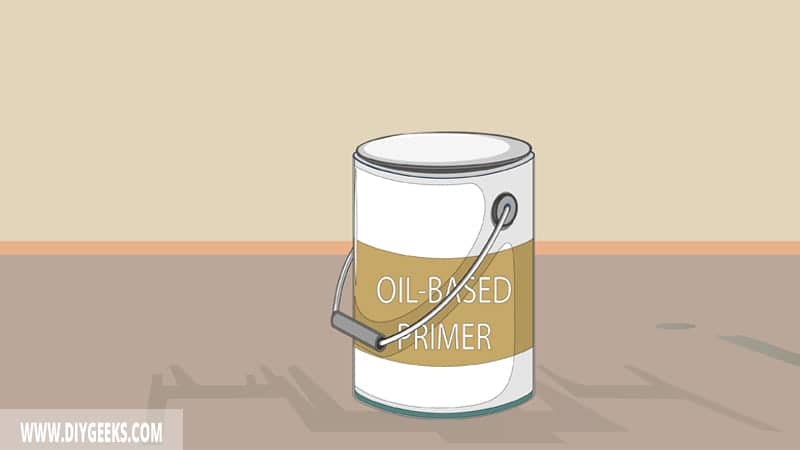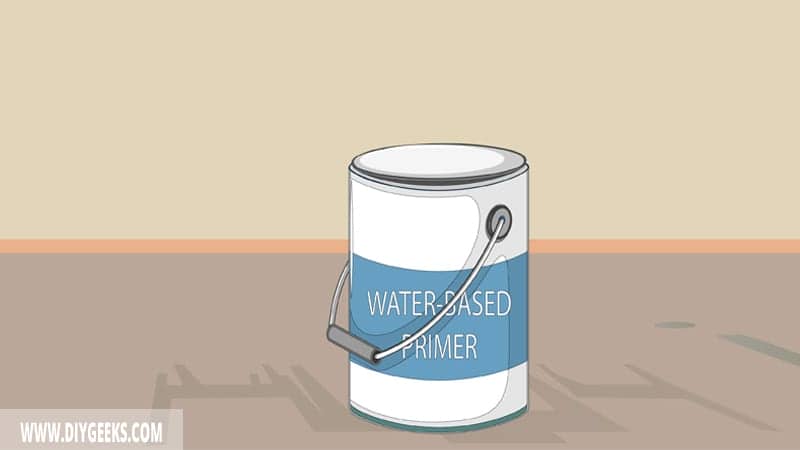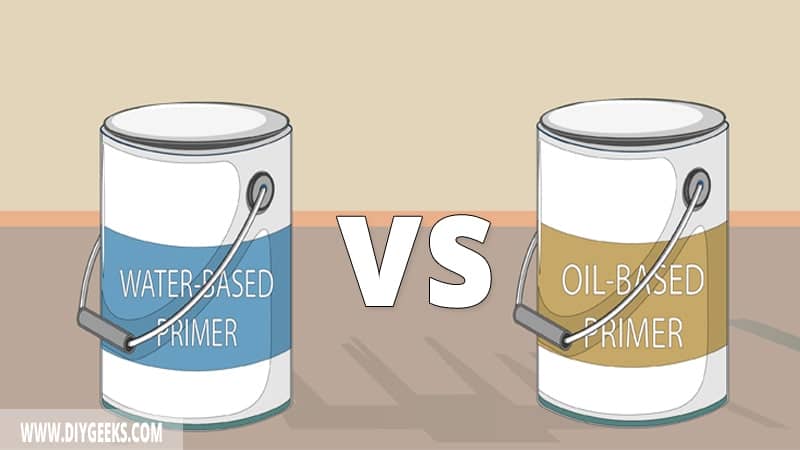Oil-based and water-based primers are both undercoats used to seal surfaces and enhance paint penetration.
Oil-based primers have better surface adhesion, durability, and seal surfaces better than water-based primers. Water-based primers have a faster dry time and are easier to clean than oil-based primers.
What is an Oil-based Primer?

Oil-based primer is an undercoat (or basecoat) that has an oil-based formula and prevents stubborn stains and moisture from bleeding through. It’s known for its good surface adhesion and durable coating that enhances paint penetration.
Oil-based primer uses oil as its main solvent which gives the primer a longer dry time. Its finish is compatible with oil-based paints or sealers.
You can use an oil-based primer for the following things.
- To Seal Stains: Use an oil-based stain-blocking primer for defective, stained, or moisture-damaged surfaces. The primer covers the surface and prevents stubborn stains from bleeding through the surface.
- Under Oil-based Paint: Oil-based primer is compatible with oil-based paint.
- Water-resistant Feature: Use stain-blocking primer over a damp surface to prevent moisture from affecting the paint finish.
What is a Water-based Primer?

Water-based primer is an undercoat that uses water as its main solvent to carry pigments and other additives. It creates a thin finish with a fast dry time and seals surface stains.
It is commonly used for areas that require prep work before painting. It can be easily sanded or shaped to bring out the desired finish.
You can use water-based primer for the following things.
- Over Interior Surface: Use water-based primer over interior surfaces.
- Water-based Paint: Use a water-based primer before applying water-based paint.
- Fast Dry Time: Use a water-based primer if you want a fast-drying primer.
Oil-Based vs Water-Based Primers
The differences between oil-based and water-based primers are listed below.
Formula
Water-based primer has a water-based formula made of solvent (water), colorants, and a binder. Oil-based primer has an oil-based formula that uses oil as its solvent.
The difference in solvent makes both primers have different finish types, dry time, and features.
Dry Time
Water-based primer dries faster than oil-based primer because its solvent (water) evaporates faster. Water-based primer takes around 30 minutes to dry between coats, while oil-based primer takes around 1 hour.
However, their exact dry time is determined by room temperature, the number of coats, and surface type.
Surface Adhesion
Oil-based primers have better surface adhesion than water-based primers. Water-based primers have good adhesion, but they can’t adhere over surface types oil-based primers do.
Paint Type
You can apply any paint type over water-based primer as its finish doesn’t repel it. You can only apply oil-based paint over oil-based primers as water-based paints don’t adhere well to it without prepping.
Durability
Oil-based primers are more durable and last longer than water-based primers as they have more additives that preserve their finish. Water-based primers aren’t as durable and can be removed if exposed to constant water.
Interior or Exterior Use
You can use water-based primers over interior surfaces only as the primer isn’t durable enough to withstand or adhere over exterior surfaces.
You can use oil-based primers over interior and exterior surfaces as the primer is durable enough to withstand outdoor weather elements. Since oil-based primers have better adhesion, they adhere over exterior damp surfaces and block stubborn stains better.
Clean-Up
Water-based primers are easier to clean than oil-based primers as you can use water to clean them. You can clean oil-based primers with a solvent only.
Sealing and Blocking
Oil-based primers block stubborn stains, oils, and moisture better than water-based primers. Water-based primers don’t seal damp or stained surfaces as good and don’t prevent bleed-through.
Finish Texture
Oil-based primers create a harder finish when dry, while water-based primers create a dull and flexible textured finish. The hard oil-based primer finish is obtained from the chemicals and binders on the formula.
Wood Usage
Oil-based primer is better at sealing porous wood surfaces and preventing paint over-absorption. Water-based primer is more suited for painted or stained wooden surfaces.
[su_youtube url=”https://www.youtube.com/watch?v=oyVoahNPBZk”]
[sc name=”oil-based-vs-water-based-primer”][/sc]


